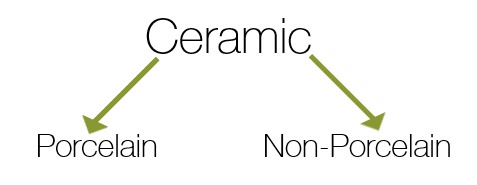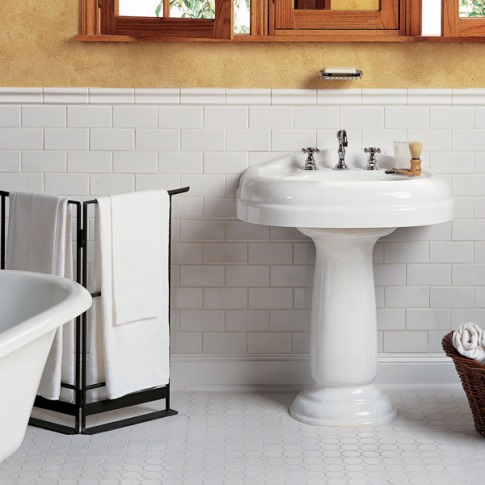Tile terminology can be confusing. When talking about tile, many homeowners refer to tiles as ceramic or porcelain as if the names were interchangeable. But it’s unclear for beginners what defines the difference – is it based on the texture? Glaze? Edges? (Hint: it’s none of these.) Most non-natural stone tiles fall within the larger category of “ceramic tiles.” The ceramic tile category is split into two groups – non-porcelain and porcelain.

How do you tell the difference between non-porcelain and porcelain tiles? We recently had the tile experts from Ames Tile in for a tile product knowledge session and they broke the difference down in one simple sentence
“Porcelain tiles are stronger and less porous than non-porcelain, with a water absorption rate of 0.5% or better.”
Non-porcelain and porcelain ceramic tiles are similar in many ways – both can be glazed and the production method is identical. It’s the water absorption rate that differentiates the two types of tiles.
Let’s take a look at the other features and benefits of porcelain and non-porcelain ceramic tiles.
Ceramic Non-Porcelain tiles
Ceramic non-porcelain tiles (we’ll just refer to them as ceramic for simplicity) can be either glazed or unglazed. When ceramic tiles are glazed, the glaze is applied to the outside of the tile and the tile is fired in the kiln. The resulting glazed tile is hard, non-porous, stain resistant and easy to clean. Glazes can be high-gloss, matte, transparent or opaque, each creating many unique appearances. Since the glaze does not go all the way through the tile, if it is chipped a different inner colour will show through. Ceramic tiles are great for DIY’ers because they are easier to cut than porcelain tiles.
Porcelain tiles
Porcelain has a reputation for being versatile and long-lasting. Since porcelain tiles are produced using a dry-pressed or dust-pressed method, they are more dense and fine grained. They are highly resistant to moisture, staining, heavy loads and wear. The body of the tile is less porous, making it a suitable choice for high-moisture areas such as kitchens and bathrooms. Within the porcelain tile category there are a couple different types:
Unglazed porcelain tiles
Unglazed porcelain tiles are known for being very tough and dense. They are a through-coloured product, which means if they are chipped or start to wear due to heavy traffic they will keep their original colour. Unglazed porcelain tiles can have a variety of finishes from matte to high-gloss. Some unglazed tiles even have textured finishes designed to mimic natural stones. These textures come from the mould used to produce the tiles.
Glazed porcelain tiles
Glazed porcelain tiles combine many of the same benefits as unglazed porcelain tile with the wide variety of looks a glaze can provide. They can be glossy, matte, or even polished to a completely flat surface. Like glazed ceramic tiles, any chips will show the inner colour of the tile.
What are rectified edges?
Many porcelain tiles boast that they have rectified edges. A tile with rectified edges was cut after firing. Tiles shrink about 15% after they have been fired and they do not shrink evenly. Cutting tiles after they have been fired ensures that all tiles are exactly the same size.


